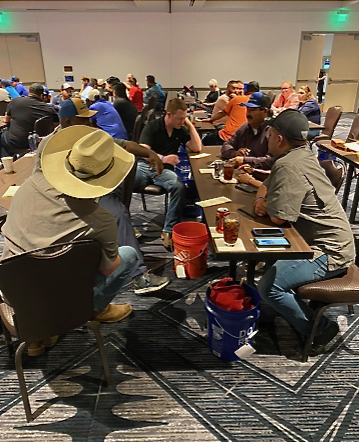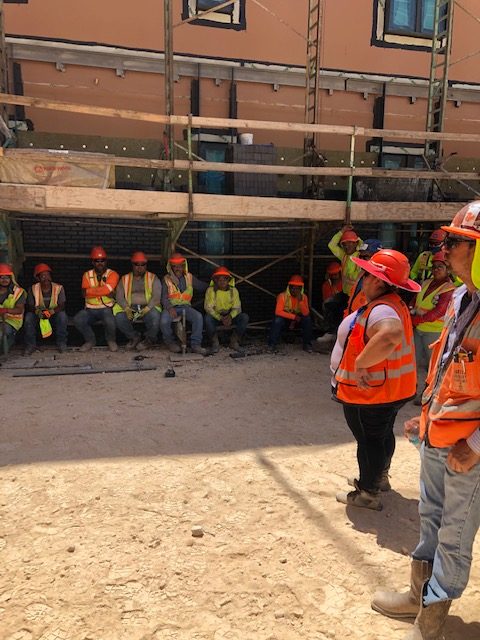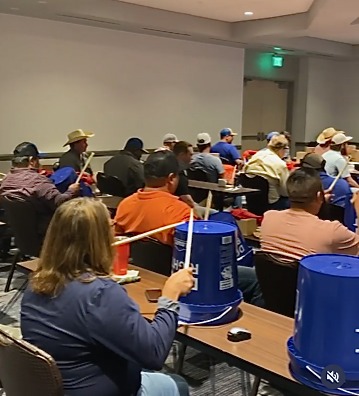MCAA Safety Talks and Their Positive Impact
Words: Zach Everett
Words and Photos: Zach Everett, CSHO, SHEP, MCCorporate Safety Director at Brazos Masonry, Inc. & Legacy Masonry, LLC
Why Are Safety Meetings Important?

They say communication is one of the most necessary and impactful ingredients in a successful marriage. Communication in a business, like masonry, is much the same. Building a culture of safety is no different. We want people to avoid injury and illness and the only way to do that is to communicate the risk in a way that they can understand and thereby avoid the potential catastrophe. Safety meetings, toolbox talks, job safety analysis reviews with the crew, or safety talks are always of communicating the proper way of doing a task to avoid the risk of injury or illness. Because communicating safety comes in various forms and terminologies, for the rest of this article I want to simply refer to it has “safety talks.” this is a generic way to describe any meetings that may be addressing safety concerns. This can be on the job site, in an office, with a general contractor, with subcontractors, pre-construction meetings, or any other venue for safety is the topic.
Likely, we have all seen situations where a safety meeting sheet was laid down in the crew told to sign off, but rather than go over the safety topic as they should, the crew one by one signs off and goes to work. This is an obvious sign that safety is not as important as it should be. It's a symptom of a deeper illness. A heart issue. Safety is not in their heart. “Pencil whipping” a safety meeting, a JSA, or JHA is missing a wonderful chance to communicate something that may save someone’s life. Some may feel that a safety meeting is simply slowing down production. That it is getting in the way of the real goal and reason for being there. Communicating safety and a meaningful way can actually increase production it help avoid shutdowns later. For example, talking about the safety of the scaffolds (and of course, incorporating what is discussed) can help make sure the scaffold is built properly. This helps everyone feel secure and safe while working rather than being distracted by missing boards, hand rails or some other issue that could impede the mental comfort of the workers. This is only one example and there are many more that we could give. Part of a well-oiled, high performing masonry crew is exemplary safety practices as part of that well-oiled machine.

The fact is mason contractors that have strong safety programs in action will benefit on their bottom line, quality, and schedule. This cannot happen without communicating the high value of safety through safety talks of every kind. When safety is not communicated adequately, injuries are the natural result. When that happens, employees stop working. That costs money. The down time will depend on the severity of the injury. Some people will stop to help the injured. Some will stop to just watch out of concern. If the injury requires EMS chances are the whole job will shut down. All the supervision will stop what they’re doing to make sure proper care is given. Time will be taken to do an injury investigation and employees will have down time writing witness statements if they saw what happened. There should be a safety meeting held immediately to inform the other crewmembers how he’s doing and what happened so that they can avoid such a hazard in the future. As more information comes out about the incident, that too should be shared with the crew. Additional training may be needed as well. There can be literally thousands of dollars spent solely in down time associated with just one injury. It will affect schedule, morale, and efficiency.
Preparation and Organization of Safety Talks
The preparation and organization of a safety talk should not be a from-the-hip, slipshod endeavor. The speaker needs to be prepared with facts as well as mentally. The topic needs to be well thought out and understood, and delivered with enthusiasm. If the speaker is not enthusiastic about his topic, his audience will not be enthusiastic about it either. I know what people are thinking: some safety topics are hard to be enthusiastic about. The way to conquer this is to bring it down to a personal level. Wearing hard hats is not terribly exciting, right? But if you talk about something falling off the top of a building and striking one of our coworkers that are standing here that's not wearing a hard hat and it kills them, who is going to take care of his wife and kids? This is how we can take, somewhat mundane topics, and make them relevant and meaningful. In addition to the facts of wearing a good hard hat or having overhead protection or making sure no one is working over you at all, throw in a true story of someone's life that was affected by a falling object. This could be used as hook to make sure the message sinks in.

Often safety talks are delivered on the job site by the Superintendent to the crew. In most companies there is a safety person that prepares the safety talk and sends it out to each Superintendent in the company. This takes a huge burden off of the Superintendent, so that he doesn't have to go out and research and find topics himself. Even if someone doesn't have a safety person doing the research for them, there are many resources on the Internet. Someone can do a brief Internet search for safety talks and come up with something that is relevant and needed for the crew in a short amount of time. Members of the MCAA have access to hundreds of ready to deliver safety talks on the MCAA a website. Even if someone else is doing the research, the person delivering the safety talk needs to make it his own. Think of stories from your personal life that you can incorporate into the topic. Consider the job tasks for the day and include them into the topic as well. The more relevant and personally applicable the safety talk is the more the crew will embrace it willingly. They will also remember what was discussed in the safety talk when they see the issue in the field later in the day.
Who Should Deliver the Safety Talk?
The Superintendent is not always the person given a safety talk. Owners of companies often address safety concerns publicly. A project manager, estimator, general Superintendent, and anyone within a company may be called upon to talk about safety. And this is a good thing. Often people think of the safety director as being the one that should do all the safety talking. This could not be farther from the truth. Everyone in the company should be talking about safety. That is what a true safety culture is all about. And whether it's the Superintendent, the safety director, or the president of the company, we should try to in list participation during the talk. When someone participates in something they remember it better and longer. Ask for personal experiences from the crew or the audience. Let them be the teacher. Of course, you may have to direct the conversation sometimes. But that's just part of having an audience.
The Impact on the Safety Culture
We communicate in different ways. It's not just speaking. We can communicate safety by PowerPoint presentations, newsletters, a personal note or card, at a big corporate meeting, or an impromptu discussion at the tailgate. The constant, non stop communicating of the importance of safety from the top down in a company is how a safety culture is formed. The key is communication! And part of that is the age old “Safety Talk.”